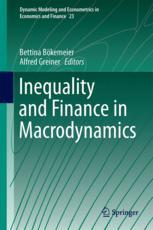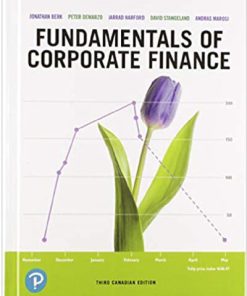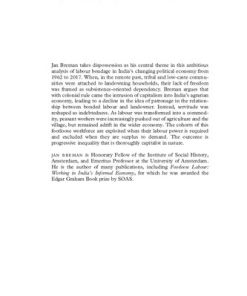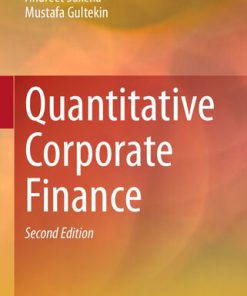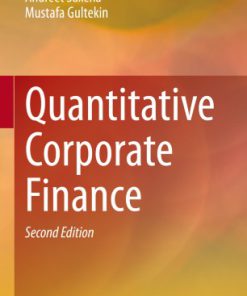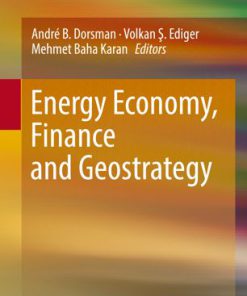Inequality and Finance in Macrodynamics 1st Edition by Bettina Bokemeier, Alfred Greiner ISBN 3319546902 9783319546902
$50.00 Original price was: $50.00.$25.00Current price is: $25.00.
Inequality and Finance in Macrodynamics 1st Edition by Bettina Bokemeier, Alfred Greiner – Ebook PDF Instant Download/Delivery: 3319546902, 9783319546902
Full download Inequality and Finance in Macrodynamics 1st Edition after payment
Product details:
ISBN 10: 3319546902
ISBN 13: 9783319546902
Author: Bettina Bokemeier, Alfred Greiner
This contributed volume combines approaches of the current inequality debate with aspects of finance based on profound macroeconomic model analyses. Research on inequality has had a long tradition in economics. With the financial crisis from 2007, not only output decreased tremendously, but also inequality has risen since then. The book presents selected contributions of a workshop held at Bielefeld University in 2016 and features additional papers written by experts in the field. A mixture of established researchers and young scholars presents both theoretical and empirical frameworks to analyze the subject.
Inequality and Finance in Macrodynamics 1st Table of contents:
1 Introduction
2 Some Data
2.1 Income Inequality
2.2 Wealth Inequality
3 Conclusion
References
Assessing Public Spending Efficiency in 20 OECD Countries
1 Introduction
2 Literature
3 Methodology and Data
3.1 Public Sector Performance (PSE)
3.2 Public Sector Efficiency
3.3 Data Envelopment Analysis (DEA)
4 Empirical Analysis
4.1 Public Sector Performance
4.2 Public Sector Efficiency (PSE)
4.3 Data Envelopment Analysis (DEA)
5 Conclusion
Appendix
References
Government Debt, Fiscal Rules and Singular Growth Dynamics
1 Introduction
2 The Model
2.1 Endogenous Debt Adjustment
2.2 The DGE in Detrended Variables
3 Local Analysis
3.1 Impasse-Surface
3.2 Balanced Growth Paths and Local Dynamics
4 Equilibrium Dynamics
4.1 Multiple Over-Determined BGP’s
4.2 Determinate BGP’s
5 Conclusion
Appendix: Proofs
References
Financial Liberalization, Inequality and Inclusion in Low-Income Countries
1 Introduction
2 Literature Review
3 Data Description
3.1 Measuring Income Inequality
3.2 Measuring Capital Account Openness
3.3 Identification Strategy
4 Methodology
4.1 The Baseline
4.2 Mechanisms: Financial Development and Inclusion
5 Results
5.1 The Baseline
5.1.1 Baseline Results
5.1.2 Robustness Check with Local Projection Method
5.1.3 Difference Between Equity, Bond and FDI Liberalization
5.2 Mechanisms: Financial Development and Inclusion
6 Conclusion
Appendix: Data Appendix
Current Account Openness Index
Regulation Reform
Macroeconomic Variables
Redistributive Policies
Credit Market Freedom Indicator
Financial Inclusion
References
On (Non-)Neutrality of Public Debt in Growing Economies
1 Introduction
2 The Growth Model with Flexible Wages and Elastic Labour Supply
2.1 Model Structure
2.1.1 The Household
2.1.2 The Productive Sector
2.1.3 The Government
2.1.4 Equilibrium Conditions and the Balanced Growth Path
2.2 Analysis of the Model
3 The Model with Wage Rigidity
3.1 The Model Setup
3.1.1 The Household Sector
3.1.2 The Productive Sector and the Labor Market
3.1.3 The Government
3.1.4 Equilibrium Conditions and Balanced Growth
4 Analysis of the Model
5 Conclusion
Appendix
Proof of Proposition 1
Proof of Proposition 2
Proof of Lemma 7
Proof of Proposition 3
Proof of Proposition 4
Proof of Proposition 5
Proof of Proposition 6
References
Financial Intermediation and Directed Technical Change
1 Introduction
2 The Model
2.1 The Economy
2.2 Production Sectors
2.2.1 Final Output
2.2.2 Intermediate Production
2.2.3 Capital Goods Production and Innovations
2.3 Heterogeneous Consumers
2.3.1 Workers
2.3.2 Innovators
2.3.3 Entrepreneurs
2.4 Banking Sector
2.5 Aggregation
3 The Decentralized Equilibrium
3.1 Producer Behavior
3.1.1 Final Output
3.1.2 Intermediate Output
3.1.3 Capital Goods Production
3.2 Consumer Behavior
3.3 Banking Behavior
3.4 Market Clearing
3.4.1 Capital Markets
3.4.2 Factor Markets
3.4.3 Goods Markets
3.5 Equilibrium
4 Determinants of Directed Technical Change
4.1 The Demand for Innovations
4.2 The Supply of Innovations
5 Properties of the Balanced Growth Path Equilibrium
6 Conclusions
Appendix: Mathematical Appendix
Proof of Lemma 1
Derivation of ω̃ (Eq.(76))
Proof of Lemma 2
Proof of Lemma 3
References
Sustainability of Public Debt in an AK Model with Complex Tax System
1 Introduction
2 Model
2.1 Household
2.2 Firms
2.3 Government
2.4 Market Clearing Conditions
3 Equilibrium
3.1 Equilibrium Path
3.2 Balanced Growth Path
4 Sustainability of Public Debt
4.1 Critical Level of Public Debt-to-GDP Ratio
4.2 Marginal Rates of Substitution of the Tax Rates
4.3 Required Tax Rates for the Sustainability of the Public Debt
4.4 Numerical Example
5 Conclusion
References
Demographic Change and the Rates of Return to Risky Capital and Safe Debt
1 Introduction
2 The Model
2.1 Government Debt
2.2 Households
2.2.1 Equilibrium
2.3 Baby Boom and Equity Premium
3 Extensions
3.1 The Effect of Human Capital
3.2 Portfolio Choice
4 Discussion
5 Conclusion
References
Financing Sustainable Growth Through Energy Exports and Implications for Human Capital Investment
1 Introduction
2 Historical and Statistical Facts
3 Basic Model of a Closed Economy and Its Solution
4 Open Economy Model with Resources and Its Solutions
4.1 Theoretical Model
4.2 Numerical Solution of the Open Economy Model
5 Open Economy Model with Human Capital and Its Solutions
5.1 Theoretical Model
5.2 Numerical Solutions
6 Conclusion
Appendix 1
Appendix 2
Appendix 3
Appendix 4
References
Macroeconomic Risk, Fiscal Policy Rules and Aggregate Volatility in Asymmetric Currency Unions: A Be
1 Introduction
2 The Model
2.1 Households
2.2 Firms
2.3 Monetary Authorities
2.4 Fiscal Authorities
2.5 Sovereign Risk
2.6 Market Clearing and External Imbalances
3 Model Analysis
3.1 Transmission Mechanisms and Dynamic Adjustments
3.2 Debt Stabilization Policy and Its Effect on the Macroeconomic Stability
3.3 Adjustment Volatility Under Alternative Sovereign Risk Perceptions and Fiscal Policy Rules
3.3.1 Scenario 1: Consensus Between Government and Markets About Sovereign Debt as the Main Determin
3.3.2 Scenario 2: Disagreement About the Main Determinant of Sovereign Risk (Government: Sovereign D
3.3.3 Scenario 3: Consensus Between Government and Markets About the Output Gap as the Main Determin
3.3.4 Scenario 4: Disagreement About the Main Determinant of Sovereign Risk (Government: Sovereign D
4 Concluding Remarks
References
Asset Accumulation with Heterogeneous Households: The Rise of Wealth Disparity
1 Introduction
2 A Model with Heterogeneous Households
2.1 High Net Worth Households
2.2 Low Net Worth Households
2.3 Wealth Distribution
3 Empirical Trends
3.1 Data Sources, Methodology and Measures
3.2 Distribution of Net Wealth
3.3 Income Brackets and Income Sources
3.4 Life Cycle Aspects of Income and Wealth
3.5 Capital Income Trends
4 Private Wealth and Public Policies
5 Conclusions
People also search for Inequality and Finance in Macrodynamics 1st:
inequality and finance in macrodynamics
inequality in finance
inequality macroeconomics
inequality and business cycles
inequality and measured growth
Tags:
Bettina Bokemeier,Alfred Greiner,Inequality,Finance,Macrodynamics
You may also like…
Business & Economics - Professional Finance
Fundamentals of Corporate Finance, 3rd Canadian Edition Jonathan B. Berk
Science (General)
Politics & Philosophy - Government & Politics
Capitalism Inequality and Labour in India 1st Edition Jan Breman
Business & Economics - Management & Leadership
Quantitative Corporate Finance 2nd Edition John B. Guerard Jr.
Business & Economics - Management & Leadership
Business & Economics
Energy Economy, Finance and Geostrategy André 3319768670 9783319768670
Business & Economics - Personal Finance


